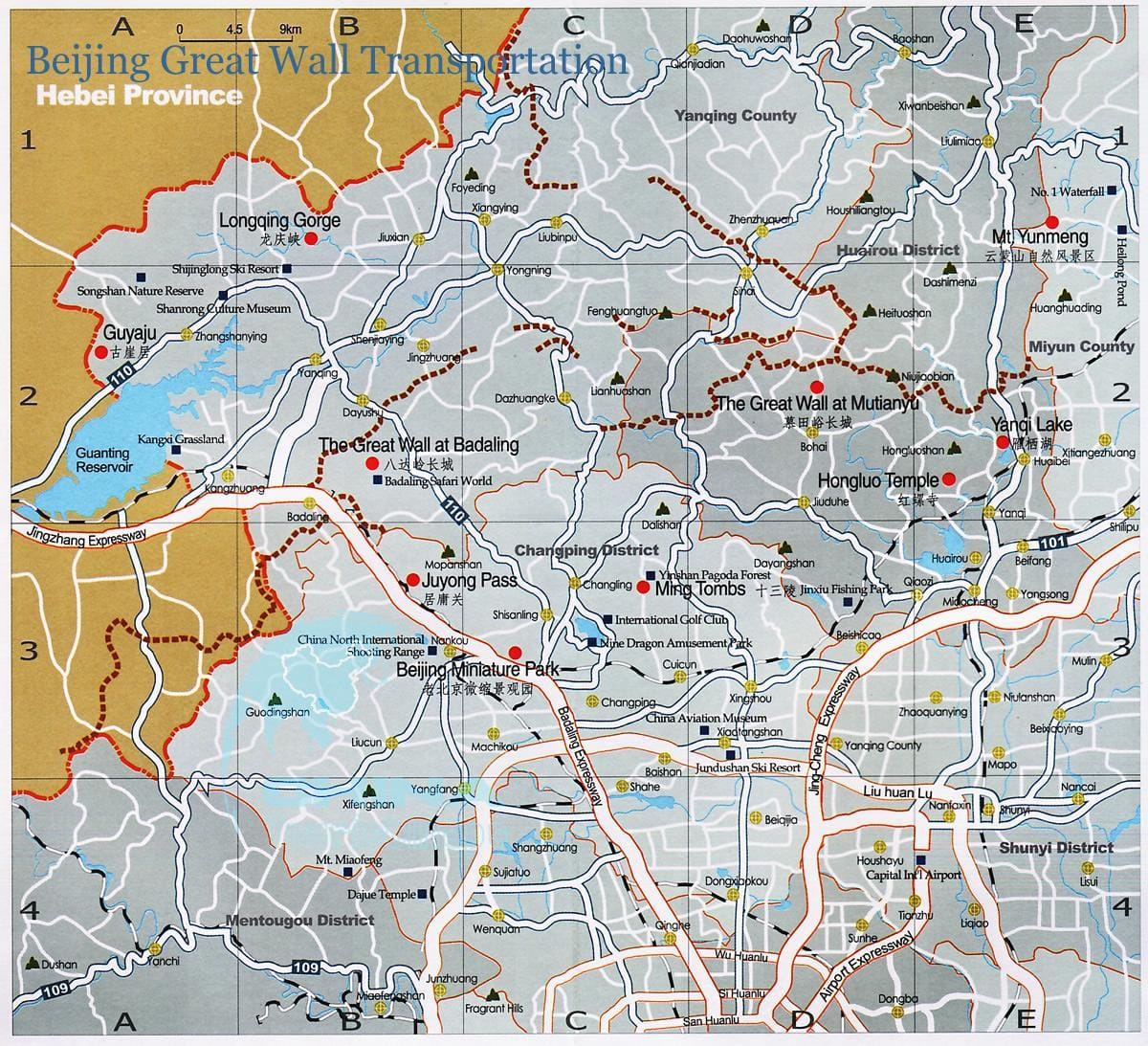Hey there, history buffs and adventure seekers! Get ready to unlock the secrets of Beijing, a city where ancient history meets modern energy. This guide is your key to navigating Beijing like a pro, using a treasure trove of maps to uncover hidden gems and explore iconic landmarks. So buckle up, grab your guide, and get ready for a captivating journey through time!
Unlocking Beijing: Why Maps Are Your Secret Weapon
Navigating the captivating blend of old and new that defines Beijing can be a thrilling but daunting experience. That’s where Pechino maps, your secret weapon to unlocking this incredible city, come in. These maps are your trusty sidekicks, guiding you through famous spots like the Forbidden City and those charming, maze-like hutong alleyways.
What Kind of Maps Will You Encounter?
The good news is you have a variety of Pechino map options, each catering to different travel styles and preferences:
- The Old Reliable: Google Maps
This versatile tool needs little introduction. Explore the city layout, use street views to preview your destination, enjoy real-time traffic updates (essential in bustling Beijing!), and discover countless points of interest, all in one place.
Interactive and Fun: City Guide Websites
For a more visually engaging experience, try websites like “Scopri Pechino.” These platforms offer interactive maps highlighting must-see attractions, museums, and landmarks.
Be Your Own Map Master: Google My Maps
Ever dreamed of creating your own personalized map? Now you can! Google My Maps empowers you to focus on specific areas, create themed maps (like “Best Dumpling Spots in Beijing”), or plan your entire itinerary, all within a single platform.
Subway Savvy: Transportation Maps
Beijing’s public transportation system, particularly its subway, is impressive. Dedicated “Beijing Subway maps” are your ticket to seamless travel on this extensive network.
Tourist-Friendly Guides: Tourist Maps
- Designed with visitors in mind, these maps pinpoint famous attractions, recommend hotels, and even suggest sightseeing routes, making it easy to hit the ground running.
Why Bother with Pechino Maps? Here’s How They Enhance Your Journey:
- Plan Like a Pro: Before you even set foot in Beijing, Pechino maps allow you to visualize distances, scout potential hotels, and create a preliminary itinerary, ensuring a more organized and enjoyable trip.
- Navigate Like a Local: Navigating a new city can be intimidating, but not with a map in hand (or on your phone!). Pechino maps keep you on track and confident, whether you’re using public transit, walking, or taking a taxi.
- Uncover Hidden Gems: One of the greatest joys of travel is stumbling upon unexpected treasures. Interactive maps often lead you to charming local eateries, hidden alleyways, and cool spots often missed in traditional guidebooks.
- Deeper Cultural Understanding: Some Pechino maps provide historical context, enriching your explorations. Seeing the Forbidden City is one thing; understanding its history and significance elevates the experience.
Key Features to Look For in Your Ideal Pechino Map:
- Lost in Translation? No Problem: Many maps offer translations in multiple languages, eliminating language barriers and ensuring a smoother experience.
- Offline Access is Key: Don’t rely solely on Wi-Fi or data. Download maps for offline use to avoid getting lost when connectivity is limited.
- Get Interactive: Zoom in, pan around, click on points of interest for more info – interactive maps make exploring far more engaging and informative.
- Make it Your Own: Customize your routes, save favorite spots, and share your discoveries with friends and family back home to inspire their own adventures.
In a Nutshell:
Pechino maps are more than just navigational tools – they’re your passport to a richer, more immersive Beijing experience. From planning adventures to uncovering hidden gems and delving into the city’s captivating history, a good map is your best friend in Beijing. So, choose your weapon (or app!) and get ready to explore this amazing city like a pro!
Unleashing the Power of Thematic Maps: Stories Hidden in Plain Sight
We’ve talked about general maps, but let’s dive into the captivating world of thematic maps. These maps are like detectives, uncovering hidden stories within data connected to specific locations.
Imagine, instead of just seeing state boundaries on a US map, you see each state shaded differently based on its corn production. That’s a thematic map in action! It instantly reveals patterns—are high-corn-producing states clustered together? Thematic maps help us explore such questions and understand data in a whole new light.
How Thematic Maps Bring Data to Life: Mapping Methods Unveiled
Thematic maps employ a variety of techniques to transform data into compelling visual stories:
Choropleth Maps: Picture a map where countries are colored based on average income. Darker colors might represent wealthier nations, while lighter shades indicate lower incomes. Choropleth maps excel at facilitating comparisons between regions at a glance.
Dot Density Maps: Want to visualize pizza lovers’ hotspots? A dot density map can do that! Each dot represents a certain number of pizza orders, revealing clusters of pizza fanatics. This method effectively illustrates the distribution or concentration of data points.
Isopleth Maps: Imagine weather maps with lines connecting points of equal temperature—those are isopleth maps. They are perfect for showing how something changes gradually over an area, like elevation or air pressure.
Heat Maps: As the name suggests, heat maps use color to represent intensity. In a website traffic heat map, red-hot colors could highlight the most popular pages, while cooler blues show less frequented ones.
Graduated Symbol Maps: Think of maps using different-sized circles to represent city populations. The larger the circle, the greater the population. Graduated symbol maps are excellent for illustrating variations in size or amount.
Why Thematic Maps Matter: Beyond Pretty Pictures
Thematic maps are far from just visually appealing; they’re powerful tools for understanding our world:
They make data easy to grasp and more engaging. Let’s face it, staring at spreadsheets isn’t the most exciting activity. Thematic maps transform data into captivating visuals, making it easier to identify trends and draw conclusions.
They uncover hidden connections. Remember those corn-producing states? A thematic map might reveal they also share similar rainfall patterns, suggesting a link between climate and crop yield. Thematic maps help us see such relationships, potentially leading to new discoveries.
They’re everywhere! From tracking disease outbreaks to informing election campaigns, thematic maps play a role in countless fields. Scientists, businesses, governments – all rely on these maps to make sense of complex data and make smarter decisions.
Accuracy is key. However, it’s important to remember that a well-crafted thematic map relies on accurate data and careful design. Like any tool, its effectiveness hinges on the quality of information and methods used to create it.
The world is full of fascinating stories hidden within data. Thematic maps serve as our guides, helping us unlock those stories and understand the world around us in new and exciting ways.
Which EPSG Does Google Maps Use? Unraveling the Code Behind the Map
We’ve explored the importance of EPSG codes in ensuring maps accurately represent our world. But what about Google Maps, the mapping tool many of us use daily? Which EPSG code is behind its seamless navigation?
Visualizing EPSG: From Globe to Screen
Imagine a classic globe – that’s the Earth as it truly is. EPSG:4326, also known as WGS84, represents this globe. It uses latitude and longitude to pinpoint exact locations, providing extremely accurate coordinates.
Now, imagine flattening that globe into a paper map. It’s not a straightforward process; direct flattening would distort everything! That’s where map projections come in. EPSG:3857, also known as Web Mercator, is Google Maps’ choice for displaying the world on your screen. This projection stretches things out, especially near the poles, but it makes navigation and zooming in and out incredibly smooth.
Google Maps: A Two-Code System
The beauty of Google Maps lies in its clever use of both EPSG codes, each serving a distinct purpose:
What You See: When you use Google Maps, you’re seeing the world projected using EPSG:3857 (Web Mercator). This ensures a visually appealing and user-friendly experience with streets aligning nicely and seamless zooming.
Behind the Scenes: Google Maps stores and processes location data using EPSG:4326 (WGS84), ensuring accuracy and consistency with real-world coordinates.
Think of it like this: you dress up for a presentation (that’s EPSG:3857, prioritizing visual appeal), but underneath, you’re still you, with your unique identity (that’s EPSG:4326, representing the accurate data).
Why Should I Care About Google Maps’ EPSG Codes?
Understanding these codes might seem like an obscure technical detail, but it can be helpful, especially:
For Mapping Professionals: If you work with geographic data in fields like GIS or urban planning, knowing how to switch between these codes is essential for data compatibility.
For Developers: If you build apps or websites using location data (ridesharing apps, delivery services, or websites with embedded maps), understanding these EPSG codes can prevent headaches and ensure location accuracy.
For the Curious Mind: Knowing how maps work makes you a more informed map user. For example, understanding that Web Mercator distorts areas near the poles explains why Greenland might appear larger on a map than it actually is.
In a Nutshell:
Google Maps cleverly utilizes two EPSG codes: EPSG:3857 for display and EPSG:4326 for underlying data. This dual system delivers a smooth and accurate mapping experience. While you don’t need to be an expert, grasping the basics can be beneficial.
What are Chaos Maps? Navigating the Unpredictable
We’ve discussed how systems can be unpredictable. Chaos maps offer a way to visually understand this unpredictability. Imagine them as special maps; instead of streets and cities, they show how a system might behave over time.
What makes chaos maps fascinating is their extreme sensitivity to their starting point. If you took two tiny steps apart and then followed the directions on a chaos map, you might end up in completely different locations! This sensitivity to initial conditions is the famous “butterfly effect”—the idea that a butterfly flapping its wings in Brazil could eventually cause a tornado in Texas.
Scientists use chaos maps to study all sorts of complex systems, such as:
- Weather Patterns: Known for their unpredictability
- Population Changes: In an ecosystem
- Stock Market Fluctuations: Trying to find patterns in the chaos
By plotting various possibilities on a chaos map, they can begin to see hidden patterns and connections, like unraveling a tangled ball of yarn.
However, chaos maps don’t offer perfect predictions. Instead, they provide a range of possibilities, a blurry picture of what might happen. And while we can’t control chaos, understanding it, with tools like chaos maps, better equips us to prepare for different scenarios and make informed decisions in an ever-changing world.
Want to explore more fascinating maps and their stories? Dive into the remote and mysterious location of Nikumaroro Island or journey through the vast landscapes of the Osage Reservation and uncover its rich history and cultural significance.
- Crypto Quotes’ Red Flags: Avoid Costly Mistakes - June 30, 2025
- Unlock Inspirational Crypto Quotes: Future Predictions - June 30, 2025
- Famous Bitcoin Quotes: A Deep Dive into Crypto’s History - June 30, 2025
















